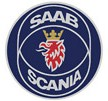 | |
| Predecessors | |
|---|---|
| Founded | 1969 |
| Defunct | 1995 |
| Fate | Split |
| Successors | |
| Headquarters | Sweden |

Saab-Scania AB was a Swedish vehicle manufacturer that was formed from the 1969 merger of Saab AB and Scania-Vabis. The company was split in 1995.
History
Truck and bus manufacturer Scania AB of Södertälje merged with car and aeroplane manufacturer Saab AB of Trollhättan on 1 September 1969, [1] [2] under the Wallenberg family group of companies. The merger meant that Saab no longer had to import the British Triumph Slant-4 engine, and could instead use the engine production facilities of Scania. In 1972 they started manufacturing the 2.0 L B version. In 1977, Saab took advantage of Scania's experience with turbochargers and added one to the engine, thus creating one of the earliest turbocharged automobile engines to be produced in large numbers.[ citation needed]
When the corporation was split in 1995, the name of the truck and bus division changed back to Scania AB. Saab Aircraft ( Saab AB) and Saab cars were also split, with General Motors buying a major holding in Saab Automobile AB.
Divisions
Saab-Scania consisted of following divisions:
- Aircraft (traded under the Saab AB brand) – until 1995
- Cars (traded under the Saab Automobile brand) – until 1990
- Trucks & Buses (traded under the Scania brand) – until 1995
Subsidiaries
Saab-Scania had following subsidiaries:
- AB Svenska Järnvägsverkstädernas Aeroplanavdelning (ASJA) – until 1981
- Jönköping – until 1983
- Nordarmatur – until 1983
- Parca Norrahammar – until 1983
- MJ – until 1984
- Enertech – to 1988
- Combitech – from 1982 to 1995
- Saab-Valmet – from 1968 to 1992
See also
- Marcus Wallenberg-hallen – Scania Museum in Södertälje, Sweden
- Swedish Air Force Museum – aircraft museum in Linköping, Sweden
References
- ^ Berg, Jørgen Seemann (1995). King of the road i femti år: Norsk Scania AS 1945–1995 (in Norwegian). Oslo, Norway: Norsk Scania AS. p. 85. ISBN 82-993693-0-4.
- ^ Gunston, Bill (2005). World Encyclopedia of Aircraft Manufacturers, 2nd Edition. Phoenix Mill, Gloucestershire, England, UK: Sutton Publishing Limited. p. 164. ISBN 0-7509-3981-8.
Further reading
- Olson, Björn (1988). The Saab-Scania Story. Stockholm: Streiffert & Co. ISBN 9178860148.
External links
- Bus manufacturers of Sweden
- Truck manufacturers of Sweden
- Defunct motor vehicle manufacturers of Sweden
- Saab
- Aircraft manufacturers of Sweden
- Scania AB
- Companies related to the Wallenberg family
- Robotics companies
- Robotics in Sweden
- Companies formerly listed on Nasdaq Stockholm
- Vehicle manufacturing companies established in 1969
- Vehicle manufacturing companies disestablished in 1995
- 1969 establishments in Sweden
- Car manufacturers of Sweden
- Swedish companies disestablished in 1995
- Swedish companies established in 1969
 | |
| Predecessors | |
|---|---|
| Founded | 1969 |
| Defunct | 1995 |
| Fate | Split |
| Successors | |
| Headquarters | Sweden |

Saab-Scania AB was a Swedish vehicle manufacturer that was formed from the 1969 merger of Saab AB and Scania-Vabis. The company was split in 1995.
History
Truck and bus manufacturer Scania AB of Södertälje merged with car and aeroplane manufacturer Saab AB of Trollhättan on 1 September 1969, [1] [2] under the Wallenberg family group of companies. The merger meant that Saab no longer had to import the British Triumph Slant-4 engine, and could instead use the engine production facilities of Scania. In 1972 they started manufacturing the 2.0 L B version. In 1977, Saab took advantage of Scania's experience with turbochargers and added one to the engine, thus creating one of the earliest turbocharged automobile engines to be produced in large numbers.[ citation needed]
When the corporation was split in 1995, the name of the truck and bus division changed back to Scania AB. Saab Aircraft ( Saab AB) and Saab cars were also split, with General Motors buying a major holding in Saab Automobile AB.
Divisions
Saab-Scania consisted of following divisions:
- Aircraft (traded under the Saab AB brand) – until 1995
- Cars (traded under the Saab Automobile brand) – until 1990
- Trucks & Buses (traded under the Scania brand) – until 1995
Subsidiaries
Saab-Scania had following subsidiaries:
- AB Svenska Järnvägsverkstädernas Aeroplanavdelning (ASJA) – until 1981
- Jönköping – until 1983
- Nordarmatur – until 1983
- Parca Norrahammar – until 1983
- MJ – until 1984
- Enertech – to 1988
- Combitech – from 1982 to 1995
- Saab-Valmet – from 1968 to 1992
See also
- Marcus Wallenberg-hallen – Scania Museum in Södertälje, Sweden
- Swedish Air Force Museum – aircraft museum in Linköping, Sweden
References
- ^ Berg, Jørgen Seemann (1995). King of the road i femti år: Norsk Scania AS 1945–1995 (in Norwegian). Oslo, Norway: Norsk Scania AS. p. 85. ISBN 82-993693-0-4.
- ^ Gunston, Bill (2005). World Encyclopedia of Aircraft Manufacturers, 2nd Edition. Phoenix Mill, Gloucestershire, England, UK: Sutton Publishing Limited. p. 164. ISBN 0-7509-3981-8.
Further reading
- Olson, Björn (1988). The Saab-Scania Story. Stockholm: Streiffert & Co. ISBN 9178860148.
External links
- Bus manufacturers of Sweden
- Truck manufacturers of Sweden
- Defunct motor vehicle manufacturers of Sweden
- Saab
- Aircraft manufacturers of Sweden
- Scania AB
- Companies related to the Wallenberg family
- Robotics companies
- Robotics in Sweden
- Companies formerly listed on Nasdaq Stockholm
- Vehicle manufacturing companies established in 1969
- Vehicle manufacturing companies disestablished in 1995
- 1969 establishments in Sweden
- Car manufacturers of Sweden
- Swedish companies disestablished in 1995
- Swedish companies established in 1969